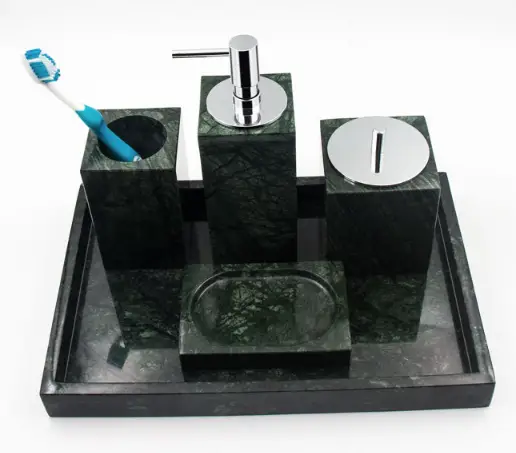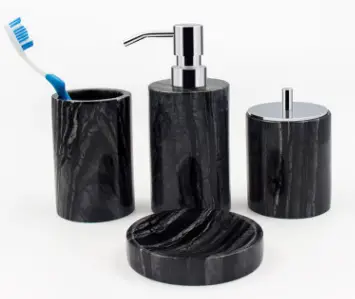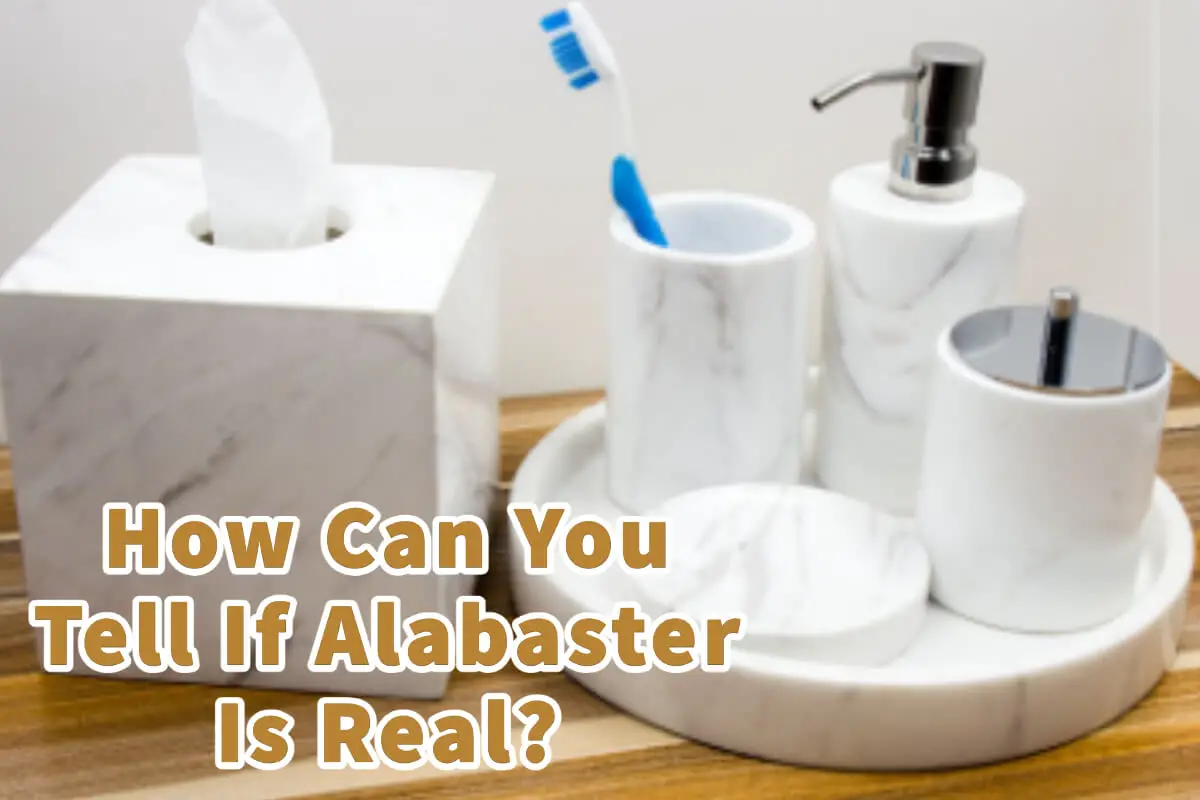Today, quite a bit of imitation alabaster is out on the market. Some of the imitation alabaster looks very good, so it can be hard to tell what is real and what is imitation.
You can check if your alabaster is genuine or an imitation alabaster. One of the main ways is through the thickness of the alabaster. The other way is by looking at the vein lines; there should be random and translucent vein lines on the genuine alabaster. The randomness of the vein lines will be very different than the imitation alabaster.
Table of Contents
- Ways To Spot The Fake Alabaster
- Genuine Alabaster Is Thicker
- The Genuine Alabaster Is Usually Heavier
- Geniune Alabaster Has Randome Vein Lines
- Natural Alabaster Should Have A Coldness
- Genuine Alabaster Is A Natural Stone
- Supplier Should List It As Fake And Not a Real Alabaster
- Natural Alabaster Should Cost More
- Nothing Compares To Real Alabaster
- Alabaster in Home Decor: Top 10 Reasons for Its Growing Popularity
- Frequently Asked Questions
- Related Content
Ways To Spot The Fake Alabaster
Even if the imitation alabaster looks real, there are still ways to spot to see if it is imitation or genuine. There are things you can do and ways to check your alabaster to see whether it is genuine or imitation alabaster.
Here are the top ways that you can check to see if your alabaster is genuine alabaster or imitation alabaster:
Genuine Alabaster Is Thicker
Natural alabaster is a soft stone; the natural alabaster would need to be thicker than some of the resin used for imitation counterparts. Genuine alabaster must be thicker than resin or imitation alabaster.

The thickness of the alabaster is one of the key ways you can tell whether or not it is genuine. The imitation alabaster does not need to be as thick as the natural alabaster.
The Genuine Alabaster Is Usually Heavier
Genuine alabaster is usually a heavier product than imitation alabaster. This is especially true if the alabaster is made with poly resin; the poly resin will usually be lighter than the genuine alabaster.
Geniune Alabaster Has Randome Vein Lines
One of the significant ways you can tell imitation alabaster from genuine alabaster is by looking at the vein lines. As alabaster is a natural stone, no two pieces of stone would be the same.
Suppose you have two pieces of alabaster side-by-side. In that case, if one is genuine alabaster and the other imitation looks slightly different, there should not be the same vein lines in the exact locations for the natural alabaster. For the imitation alabaster, the veins lines usually look more uniform and are all in the exact location on a product.
Natural Alabaster Should Have A Coldness
Genuine alabaster should also feel colder when you touch it than the imitation. If it is a natural stone, a stone wall keeps coldness to it and will feel colder than its imitation counterparts.
If the imitation alabaster is glass, it could also have a rigid feel. If it is a poly resin, it will feel warmer than the genuine alabaster, but still, the natural alabaster should have a coldness as a stone.
Genuine Alabaster Is A Natural Stone
Genuine alabaster is a natural stone. And as it is a natural stone, you should expect some variations marks or other things in the alabaster, which is all part of the nature of the stone.
The random marks would include vein lines and variations of color from piece to piece—all sorts of variations that you would expect on natural material.
Even though imitation alabaster can look similar to genuine alabaster, it will never look the same. This is because they will never be able to put in all the vein variations or natural marks as the natural alabaster will have.

Supplier Should List It As Fake And Not a Real Alabaster
A supplier or manufacturer should list the alabaster as an imitation alabaster. It may be confusing as they may use some different types of words that can all be used to describe imitation alabaster, such as:
- Alabaster Bone China
- Alabaster glass
- Faux Alabaster
Even though all of these have the name alabaster, none are considered genuine or made using natural alabaster stone.
Natural Alabaster Should Cost More
Alabaster is a natural stone that would need to be carved. The genuine alabaster item is going to cost more than the imitation alabaster.
One of the reasons is that genuine alabaster can be costly. There can be a tremendous amount of waste when mining alabaster, as alabaster is relatively delicate, and the weather can damage some of the alabaster deposits.
Also, some types of alabaster or more expensive than others because they are rare stones; this can also make a difference in the price of the alabaster stone.
If you purchase a product that seems cheaper and reasonable, and they have the word alabaster, it may not be a genuine alabaster stone.
Nothing Compares To Real Alabaster
Nothing can compare to genuine alabaster. You can see the difference quickly if you put imitation alabaster next to natural alabaster and view them in person.
It may be harder to see the difference if you only view them in a photograph. Still, in person, you should be able to see, feel and touch the difference between genuine alabaster and imitation alabaster.
We would love to talk to you if you’re interested in what type of alabaster products Mondoro Company can produce. We have some magnificent bathroom sets that are made of natural alabaster stone.
Alabaster in Home Decor: Top 10 Reasons for Its Growing Popularity
Alabaster, a fine-grained, translucent stone, has long been cherished in the world of home decor for its unique aesthetic and practical qualities.
This versatile material offers a blend of elegance and durability, making it an increasingly popular choice for interior designers and homeowners alike. Its ability to adapt to various design styles, from classic to contemporary, further enhances its appeal.
We will explore the top ten reasons why alabaster is considered a superb choice for home decor, highlighting its benefits and the distinct charm it brings to any living space.
10 Reasons Why Alabaster is a Great Home Decor Material:
- Translucency: Alabaster’s natural translucency gives it a soft, warm glow when backlit, creating a serene and inviting ambiance.
- Unique Veining: Each piece of alabaster has distinctive veining, ensuring that no two alabaster items are exactly alike, adding to their uniqueness.
- Durability: Despite its delicate appearance, alabaster is relatively durable, capable of withstanding the test of time with proper care.
- Versatility in Design: Alabaster can be incorporated into various decor styles, from minimalist to ornate, complementing a wide range of interior aesthetics.
- Elegant Finish: The stone’s smooth, matte finish provides a touch of understated elegance and sophistication to any space.
- Natural Material: Being a natural stone, alabaster adds an element of organic beauty to home interiors, appealing to those who prefer eco-friendly materials.
- Easy to Carve: Alabaster’s softness makes it easy to carve into intricate designs, allowing for custom and unique decorative pieces.
- Warm Color Palette: The warm, neutral color palette of alabaster easily harmonizes with other elements in a room, making it a versatile choice for various color schemes.
- Historical Significance: Alabaster has been used in art and architecture for centuries, bringing a sense of history and timelessness to your decor.
- Light Reflective Properties: The stone’s ability to reflect light brightens up spaces and creates a sense of openness and airiness.
Incorporating alabaster into home decor adds a touch of natural beauty and brings a unique, timeless quality to your living environment. Its blend of aesthetic appeal and functional benefits makes it a standout choice for those looking to elevate their home’s interior.
Find out more about how Mondoro can help you create, develop, and manufacture excellent home decor and home furniture products – don’t hesitate to contact me, Anita. Check out my email by clicking here or become a part of our community and join our newsletter by clicking here.
Mondoro gives out a FREE Lookbook to anyone interested. You can receive a copy of our latest Lookbook by clicking here.
Listen to our Podcast called Global Trade Gal. You can find it on all major podcast platforms. Try out listening to one of our podcasts by clicking here.
Subscribe to our Mondoro Company Limited YouTube Channel filled with great videos and information by clicking here.
Frequently Asked Questions
How can I determine if my alabaster is genuine or an imitation?
One way is to check the thickness of the alabaster. Genuine alabaster tends to be thicker than imitation alabaster.
What should I look for in the vein lines of alabaster to identify its authenticity?
Genuine alabaster will have random and translucent vein lines. These vein lines should differ significantly from the patterns found in imitation alabaster.
Are there any other characteristics I should consider when identifying genuine alabaster?
Yes, apart from thickness and vein lines, genuine alabaster tends to have a soft and smooth texture. It is also relatively cool to the touch.
Can I rely solely on the vein lines to determine if my alabaster is genuine?
While vein lines are a useful indicator, it is recommended to consider multiple characteristics, such as thickness and texture, for a more accurate identification.
Are there any specific tools I need to identify alabaster authenticity?
No, you can determine the authenticity of alabaster by carefully examining its physical characteristics with the naked eye.
Can imitation alabaster have vein lines, too?
Yes, imitation alabaster can have vein lines, but they are usually less random and translucent compared to those found in genuine alabaster.
What materials are commonly used to create imitation alabaster?
Imitation alabaster is often made using materials like resin, plaster, or synthetic substances mixed with fillers.
Are there any other visual cues that can help identify imitation alabaster?
Yes, imitation alabaster may exhibit a more uniform color, lack the natural translucency of genuine alabaster, and may feel lighter in weight.
Related Content
How To Tell The Difference Between Alabaster And Marble?
Alabaster and marble can sometimes look similar, but they have distinct differences. Alabaster is a softer stone, and marble can be highly polished. Alabaster cannot be used in any outdoor applications, but marble is used a lot outdoors for buildings and sculptures.
You can discover more by reading How To Tell The Difference Between Alabaster And Marble? by clicking here.
How Durable Is Alabaster?
Alabaster is usually considered a soft stone, and it is not as durable as other stones such as marble. Some types of alabaster can be pretty soft, and you can even scratch the alabaster with your fingernails. Alabaster is also not suited to be used outdoors and can only be used indoors.
By clicking here, you can discover more by reading How Durable Is Alabaster?
What is Alabaster? Alabaster for Home Decor Product Development
Alabaster is medium-hard gypsum or calcite mineral that is usually white and translucent and has a fine uniformed grain. When Alabaster is put up to the light, you can see the small fine natural grain of the stone. As Alabaster is a porous mineral, it can be dyed in various colors.
You can discover more by reading What is Alabaster? Alabaster for Home Decor Product Development by clicking here.


